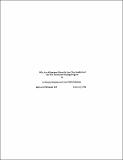| dc.contributor.author | Ellerman, A. Denny | en_US |
| dc.contributor.author | Montero, Juan-Pablo | en_US |
| dc.contributor.other | Massachusetts Institute of Technology. Center for Energy and Environmental Policy Research. | en_US |
| dc.date.accessioned | 2009-12-16T00:01:07Z | |
| dc.date.available | 2009-12-16T00:01:07Z | |
| dc.date.issued | 1996 | en_US |
| dc.identifier | 96001 | en_US |
| dc.identifier.uri | http://hdl.handle.net/1721.1/50214 | |
| dc.description.abstract | This paper presents an analysis of the reduction in SO2 emissions by electric utilities between 1985 and 1993. We find that emissions have been reduced for reasons largely unrelated to the emission reduction mandate incorporated in Title IV of the 1990 Clean Air Act Amendments. The principal reason appears to be the change in the economics of coal choice that has resulted from the remarkable decline in rail rates for low sulfur western coal delivered to higher sulfur coal-fired plants in the Midwest. We conclude that allowance prices are lower than expected because less sulfur must be removed to meet the Title IV caps on aggregate SO2 emissions. | en_US |
| dc.description.sponsorship | Supported by a grant from the National Acidic Precipitation Assessment Program of the US Government, and the Catholic University of Chile. | en_US |
| dc.format.extent | 17 p., [10] p. of plates | en_US |
| dc.publisher | MIT Center for Energy and Environmental Policy Research | en_US |
| dc.relation.ispartofseries | MIT-CEEPR (Series) ; 96-001WP. | en_US |
| dc.title | Why are allowance prices so low? : an analysis of the SO2 emissions trading program | en_US |
| dc.type | Working Paper | en_US |
| dc.identifier.oclc | 35721182 | en_US |
